Solar eclipse of April 9, 1986
A partial solar eclipse occurred on April 9, 1986. A solar eclipse occurs when the Moon passes between Earth and the Sun, thereby totally or partly obscuring the image of the Sun for a viewer on Earth. A partial solar eclipse occurs in the polar regions of the Earth when the center of the Moon's shadow misses the Earth.
| Solar eclipse of April 9, 1986 | |
|---|---|
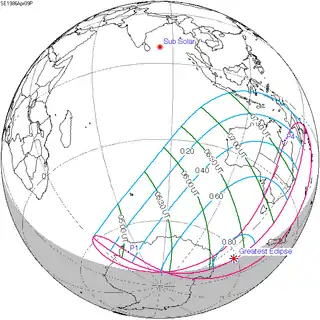 Map | |
| Type of eclipse | |
| Nature | Partial |
| Gamma | -1.0822 |
| Magnitude | 0.8236 |
| Maximum eclipse | |
| Coordinates | 61.2°S 161.4°E |
| Times (UTC) | |
| Greatest eclipse | 6:21:22 |
| References | |
| Saros | 119 (64 of 71) |
| Catalog # (SE5000) | 9478 |
Related eclipses
Eclipses of 1986
Solar eclipses of 1986–1989
There were 8 solar eclipses between April 9, 1986 and August 31, 1989.
| Solar eclipse series sets from 1986–1989 | ||||||
|---|---|---|---|---|---|---|
| Ascending node | Descending node | |||||
| Saros | Map | Gamma | Saros | Map | Gamma | |
| 119 |  1986 April 9 Partial | -1.08215 | 124 |  1986 October 3 Hybrid | 0.99305 | |
| 129 |  1987 March 29 Hybrid | -0.30531 | 134 |  1987 September 23 Annular | 0.27869 | |
| 139 |  1988 March 18 Total | 0.41879 | 144 |  1988 September 11 Annular | -0.46811 | |
| 149 |  1989 March 7 Partial | 1.09815 | 154 |  1989 August 31 Partial | -1.19279 | |
Saros 119
It is a part of Saros cycle 119, repeating every 18 years, 11 days, containing 71 events. The series started with partial solar eclipse on May 15, 850 AD. It contains total eclipses on August 9, 994 AD and August 20, 1012 with a hybrid eclipse on August 31, 1030. It has annular eclipses from September 10, 1048 through March 18, 1950. The series ends at member 71 as a partial eclipse on June 24, 2112. The longest duration of totality was only 32 seconds on August 20, 1012. The longest duration of annularity was 7 minutes, 37 seconds on September 1, 1625. The longest duration of hybridity was only 18 seconds on August 31, 1030.
| Series members 54–70 occur between 1801 and 2100: | ||
|---|---|---|
| 54 | 55 | 56 |
 December 21, 1805 |
 January 1, 1824 |
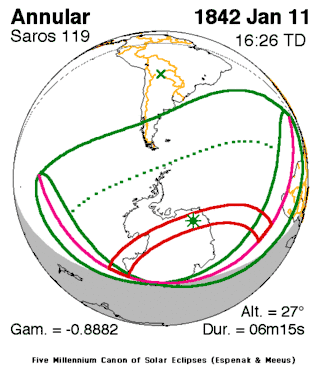 January 11, 1842 |
| 57 | 58 | 59 |
 January 23, 1860 |
 February 2, 1878 |
February 13, 1896 |
| 60 | 61 | 62 |
 February 25, 1914 |
 March 7, 1932 |
 March 18, 1950 |
| 63 | 64 | 65 |
 March 28, 1968 |
 April 9, 1986 |
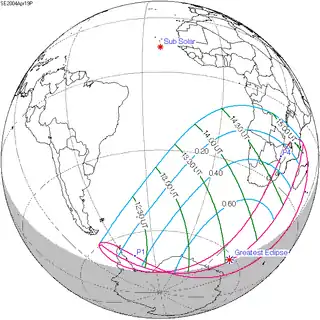 April 19, 2004 |
| 66 | 67 | 68 |
 April 30, 2022 |
 May 11, 2040 |
 May 22, 2058 |
| 69 | 70 | |
 June 1, 2076 |
 June 13, 2094 | |
Metonic series
The metonic series repeats eclipses every 19 years (6939.69 days), lasting about 5 cycles. Eclipses occur in nearly the same calendar date. In addition, the octon subseries repeats 1/5 of that or every 3.8 years (1387.94 days). All eclipses in this table occur at the Moon's ascending node.
| 21 eclipse events between June 21, 1982, and June 21, 2058 | ||||
|---|---|---|---|---|
| June 21 | April 8–9 | January 26 | November 13–14 | September 1–2 |
| 107 | 109 | 111 | 113 | 115 |
| June 21, 1963 | April 9, 1967 | January 26, 1971 | November 14, 1974 | September 2, 1978 |
| 117 | 119 | 121 | 123 | 125 |
 June 21, 1982 |
 April 9, 1986 |
 January 26, 1990 |
 November 13, 1993 |
 September 2, 1997 |
| 127 | 129 | 131 | 133 | 135 |
 June 21, 2001 |
 April 8, 2005 |
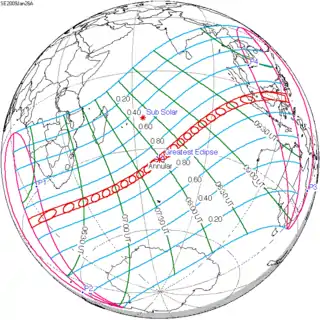 January 26, 2009 |
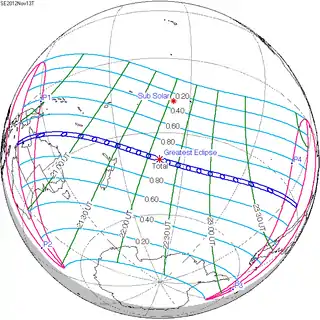 November 13, 2012 |
 September 1, 2016 |
| 137 | 139 | 141 | 143 | 145 |
 June 21, 2020 |
 April 8, 2024 |
 January 26, 2028 |
 November 14, 2031 |
 September 2, 2035 |
| 147 | 149 | 151 | 153 | 155 |
 June 21, 2039 |
 April 9, 2043 |
 January 26, 2047 |
 November 14, 2050 |
 September 2, 2054 |
| 157 | ||||
 June 21, 2058 | ||||
References
External links
- Earth visibility chart and eclipse statistics Eclipse Predictions by Fred Espenak, NASA/GSFC
.jpg.webp)

